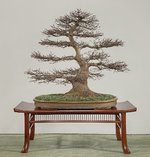Canada Bonsai
Chumono
- Messages
- 575
- Reaction score
- 2,001
The quintessential examples though are the Lascaux cave paintings (and other neolithic works). Vibrant, amazing works, yet no market potential because there was no such thing as an art market when they were made.
Interesting topic! Do you tend to think of cave paintings/carvings/drawings as art, and if so, in virtue of what? Intention? Human creation? Subjective interpretation and/or representation of world?
I have read discussions approaching this topic from 2 different chronological perspectives:
- some look at so-called 'cave art' from our current perspective, wondering what it is about these works that allow us to view them as art (we ask: do they 'qualify' as art?)
- some look at so-called 'cave art' from a perspective leading up to the work itself, wondering how it is that 'art' might have emerged from the human from a precedent that is 'not art' (let's assume that we're talking hypothetically about the earliest possible work that we might want to call 'art')
We tend to think of bonsai as a fine art; it is common to hear people compare bonsai to sculpture. But, today, isn't bonsai a lot more like film- or wine-making in at least two ways?
- The first part of the analogy: Our efforts rely heavily on tradition and the accumulation of skills, knowledge, and practices, as well as familiarity with prior works. When we act, innovate or deviate we are building on, or working in reaction to, past practices and works, similar to the way a film- or wine-maker inevitably proceeds.
- The second part of the analogy: the patterns with which our plants react to our interventions and environmental control are in some sense 'programmed' in the life form itself, very much like the wine-making process. It might initially feel like we are forcing the analogy onto film, but the chemistry and physics of the mediums (from the actors and objects to the light and sound) all have a range of natural patterns and limits of behaviour (not to say predictable behaviour) very much like the process of grape fermentation or the way that a tree responds to pruning. When a bonsai tree finally emerges from this process, we have successfully manipulated material that has a momentum of its own, which makes bonsai very much unlike paint or marble, and much more like grapes.
What are the limits of the impact we can have on the art form? Consider the 2 attached images. Is the range of 'artistic freedom' in bonsai comparable to that of wine-making?
Images taken from here: https://www.instagram.com/kokufu_maples/






